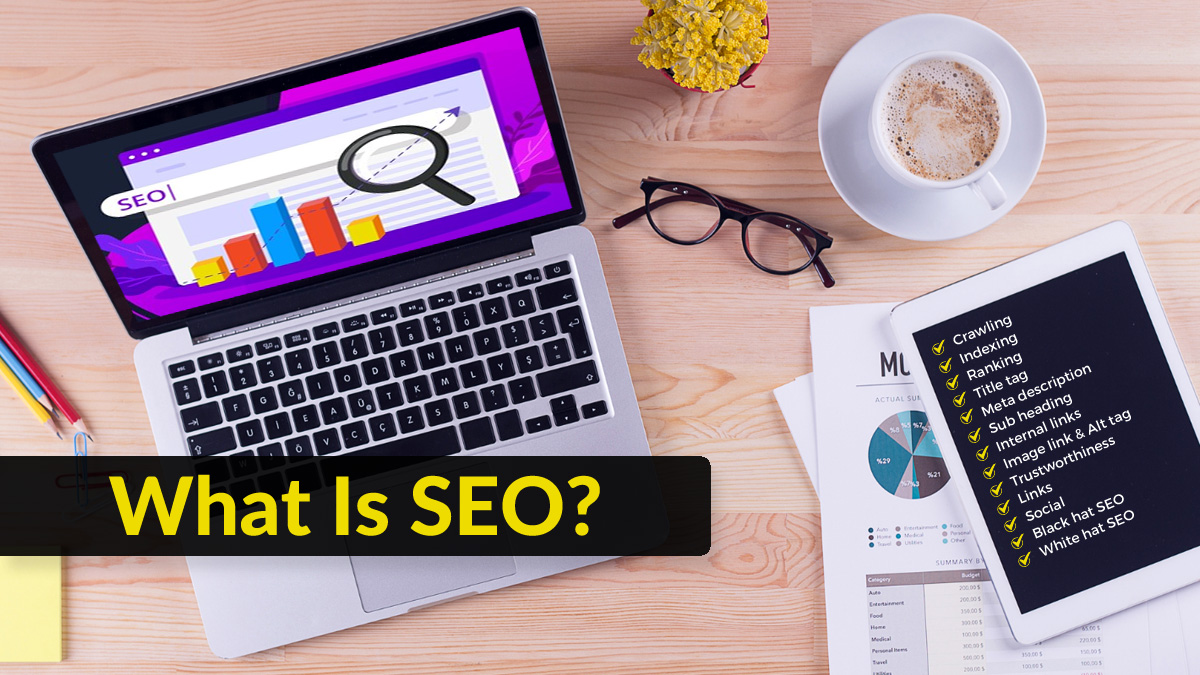New to the world of SEO? You’ve come to the right place. We’ll provide you with the essential knowledge every digital marketer should have. Search engine optimization, or SEO, is a powerful technique for elevating your website’s rankings and increasing its traffic. This guide will cover the basics as well as advanced strategies—from keyword research to on-page optimization—to help you unlock the full potential of SEO.
We’ll also discuss the impact of emerging trends in SEO, such as voice search, mobile optimization, and new technologies. By understanding these elements and implementing effective SEO strategies, you can increase your website’s visibility and attract targeted traffic. This “what is SEO” guide aims to offer actionable insights to help you navigate the digital marketplace and achieve exceptional results. Let’s dive in and uncover the secrets to enhancing your online presence.
What Is SEO?
SEO, an acronym for “Search Engine Optimization,” is the practice of increasing traffic to your website through organic search engine results. The primary objective is to improve your website’s ranking on search result pages, as a higher ranking typically leads to increased user visibility.
Executing an effective SEO strategy involves several key steps. The first is identifying relevant keywords with high search potential. Businesses can then tailor their website content to phrases that consumers commonly use when searching for specific topics.
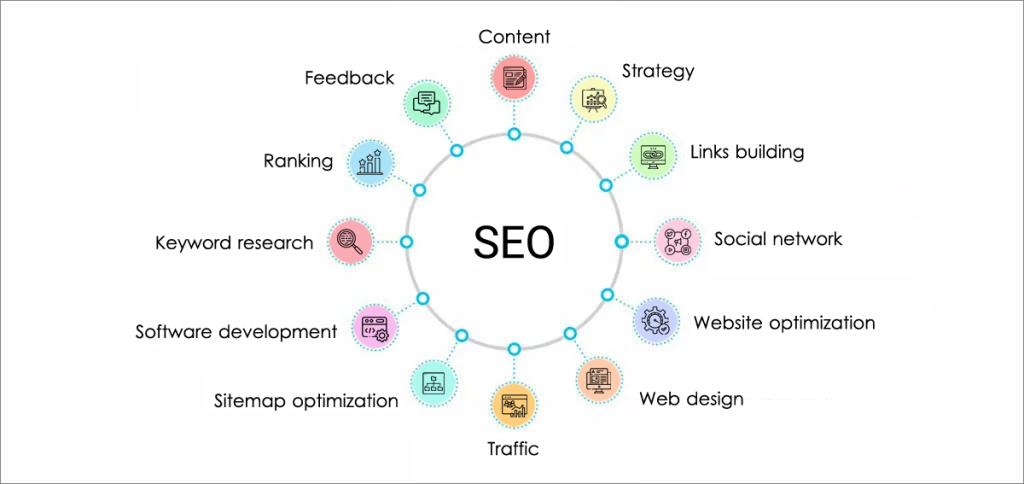
Another crucial element is creating high-quality, valuable content that caters to both user needs and search engine criteria. This ensures that your website not only attracts but also engages visitors. Incorporating links from reputable, authoritative sources is another proven SEO tactic. These links boost your website’s chances of ranking higher in search engine results by establishing its authority and relevance.
Monitoring the success of your SEO efforts is equally important. By analyzing data and metrics, SEO services providers can assess the effectiveness of their strategy and make necessary adjustments to optimize performance. In today’s digital age, SEO has become an integral part of marketing strategies. Its importance is underscored by its potential to significantly enhance a website’s visibility, thereby attracting more users and prospective customers.
How Does SEO Work?
SEO functions by making specific modifications to a website’s design and content to make it more attractive to search engines. The ultimate goal is for the site to appear at the top of the search engine results page (SERP). As previously mentioned, Google’s algorithm determines which websites appear in search results and in what order, based on a variety of ranking factors.
While it may be impractical to tackle every single element, there are recommended steps that can be taken. Whether a business is launching a new website, building product pages, or revamping an existing site, SEO might initially seem daunting. However, it doesn’t have to be overwhelming. Even if you don’t have an in-house SEO expert, you can still make incremental changes to improve your site’s SEO.
Paid vs. Organic Search: What’s the Difference?
It’s essential to understand the differences between paid search and organic search, also commonly known as SEO. Here are five key distinctions:
| Difference | Paid Search | Organic Search |
| Position | The results usually appear at the top of SERPs. | The results typically appear beneath the paid search results |
| Time | Results are almost instant, sometimes in minutes. | Results often take weeks, months, or even years. |
| Payment | Traffic is paid through pay-per-click (PPC) on a cost-per-click (CPC) basis. | Although traffic is free, it necessitates an investment of resources and time. |
| ROI | With more keyword data available in Google Analytics, it is easier to measure. | It is more difficult to quantify, but it frequently improves over time. |
| Share of Traffic | Roughly 20% and 30% of searchers click on paid results. | Around 70% to 80% of searchers click on organic results. |
What’s Common Between Paid and Organic Search
Both paid and organic search methods share similarities, as well as differences, that should be considered:
- One shared aspect is keyword research. Users rely on search engines and enter keywords to find relevant information, applicable to both sponsored and organic searches. Thus, identifying the right keywords is crucial for both paid and organic search strategies.
- Another common ground is the creation of landing pages. Both types of search require landing pages. For organic search, the landing page should link back to your website. Paid search offers more flexibility; you can either use the same landing page or create a unique, standalone page that isn’t tied to your website.
- Generating traffic is an essential objective for both paid and organic searches. User intent exists in both methods of search. Regardless of whether they are using organic or sponsored search, users are in search of answers or information. Once they find what they’re looking for, they are more likely to take action.
Three Key Aspects of SEO
Understanding how to make your brand, website, or business visible to searchers is vital for digital marketers. To stay competitive, it’s essential to keep up with SEO trends. Although SEO undergoes frequent updates, its fundamental principles remain constant. Here are the three core elements or pillars that marketers should be aware of and consistently implement:
- Technical Optimization: Technical optimization involves making changes to your website unrelated to content but aimed at enhancing SEO. Typically, these activities occur in the background.
- On-Page Optimization: The objective of on-page optimization is to ensure that your website’s content is relevant and provides an excellent user experience. This can be achieved through content management systems like WordPress, Wix, Drupal, Joomla, Magento, Shopify, and Expression Engine, and involves focusing on the right keywords to optimize your content.
- Off-Page Optimization: Off-page optimization aims to elevate your website’s ranking in search results through actions taken outside of your actual website. This primarily involves creating backlinks to bolster your website’s reputation.
How do Search Engines Work
When individuals have questions and seek online answers, they turn to search engines. The algorithms behind these search engines examine various factors to provide users with the most relevant results. These algorithms help search engines locate websites and determine their rankings for specific keywords. The search engine process consists of three main stages: crawling (the discovery stage), indexing (the organization stage), and ranking (the retrieval stage).
Crawling
Crawling is the initial step in this process. Search engines deploy web crawlers, commonly known as spiders or bots, to discover new web pages and collect information about them. These web crawlers have two primary objectives: to identify newly available web pages and to periodically revisit previously discovered pages to check for updates or changes.
When it comes to crawling, search engines depend on links they’ve previously encountered. For example, if your homepage includes a link to a new blog post you’ve written, a search engine crawler will follow that link when it visits your homepage, potentially discovering your new blog post.
In other words, search engines use links as pathways between websites. By following these links, they discover and access various types of content, including blog posts, images, videos, and other forms of media. Through this mechanism, web crawlers are able to explore and collect data from numerous web pages, helping search engines build an index of the internet.
To ensure your website appears in organic search results, it’s critical that your web pages are easily accessible and interconnected in a way that allows search engine crawlers to find and successfully navigate them.
Indexing
Indexing is the second step in the process. During this stage, a search engine evaluates the content it has crawled to determine its relevance and usefulness. In simpler terms, after scanning various web pages and collecting data, the search engine decides which pages merit inclusion in its index.
Think of the index as a massive database that stores all web pages and their associated information. This index is crucial for the final ranking phase. When you enter a query, the search engine rapidly searches its index to find relevant web pages and information to display in the search results. In this way, indexing enables search engines to respond to user queries more efficiently.
However, not all web pages are automatically indexed. Several factors can prevent a page from being included:
- Duplicate Content: If a web page contains content that is identical to that on another site, the search engine may consider it redundant and choose not to index it.
- Low-Value or Spammy Content: Search engines aim to provide users with reliable and accurate information. If a website’s content is deemed low-quality, spammy, or misleading, it may not be indexed.
- Inability to Crawl: Search engines may encounter difficulties in accessing and evaluating certain websites, either due to technical issues or restrictions set by website owners. If a page can’t be successfully crawled, it is unlikely to be indexed.
- Lack of Inbound Links: Also known as backlinks, these are links from other websites that point to a specific web page. They serve as indicators of authority and relevance. If a website or web page lacks sufficient inbound links, a search engine may consider it less authoritative and opt not to index it.
By considering these factors during the indexing process, search engines aim to deliver search results that are relevant, trustworthy, and valuable to users.
Also Read: 20 Best Rank Tracking Tools for Online Businesses in 2025
Ranking
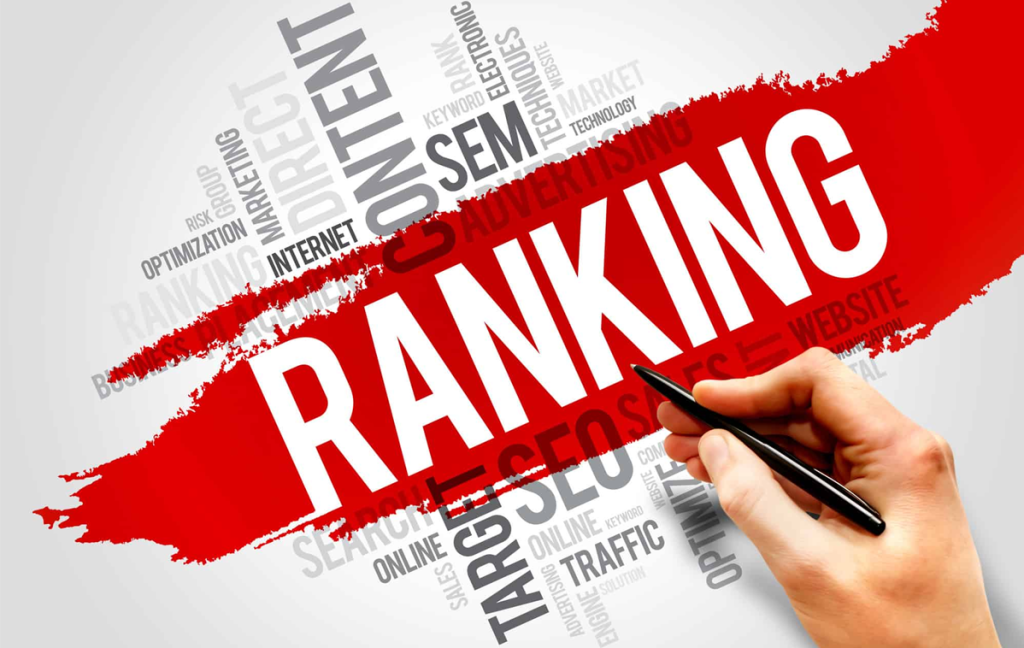
The third and most crucial phase in the process is ranking. This stage becomes relevant only after the crawling and indexing phases are complete. Once a search engine has crawled your website and indexed its content, it can begin the process of ranking it.
Search engines use more than 200 ranking signals to categorize and rank content. These signals encompass the three SEO pillars: technical optimization, on-page optimization, and off-page optimization. Here are some examples of signals that search engines consider when ranking web pages:
- Keyword Presence: The presence of the target keyword or its synonyms in the title tag is a factor that search engines consider when assessing a page’s relevance.
- Page Loading Speed: Search engines evaluate whether a page loads quickly and is mobile-friendly.
- Website Reputation: Search engines assess both the individual web page and the overall website to determine if they are reliable sources for a given query.
These are just a few of the many signals that significantly influence website rankings.
What Is SEO Marketing?
When it comes to SEO (Search Engine Optimization), the concepts of SEO and SEO marketing can seem overwhelming to many. This is because numerous factors influence your website’s ranking and authority.
However, optimizing your website for search engines is not as complicated as it may seem. In fact, it could be simpler than you think. It’s also important to distinguish between SEO marketing and search engine marketing (SEM); while they are related, they are not the same.
SEO marketing involves integrating SEO tactics into a broader marketing strategy. The aim is to enhance a website’s visibility and generate organic traffic through search engine results by optimizing various website components and employing strategies such as keyword targeting, content creation, and link building.
In contrast, search engine marketing encompasses paid advertising, pay-per-click (PPC) campaigns, and other methods designed to increase a website’s visibility on search engine results pages, along with a wider range of marketing activities.
By incorporating SEO strategies into their overall marketing plan, businesses can improve their online visibility, attract a larger audience, and increase organic traffic. This, in turn, will likely lead to higher conversion rates and business growth.
So, while SEO marketing and search engine marketing have similarities, it’s essential to understand their differences and how to leverage each effectively to achieve your marketing goals.
How SEO Marketing Functions?
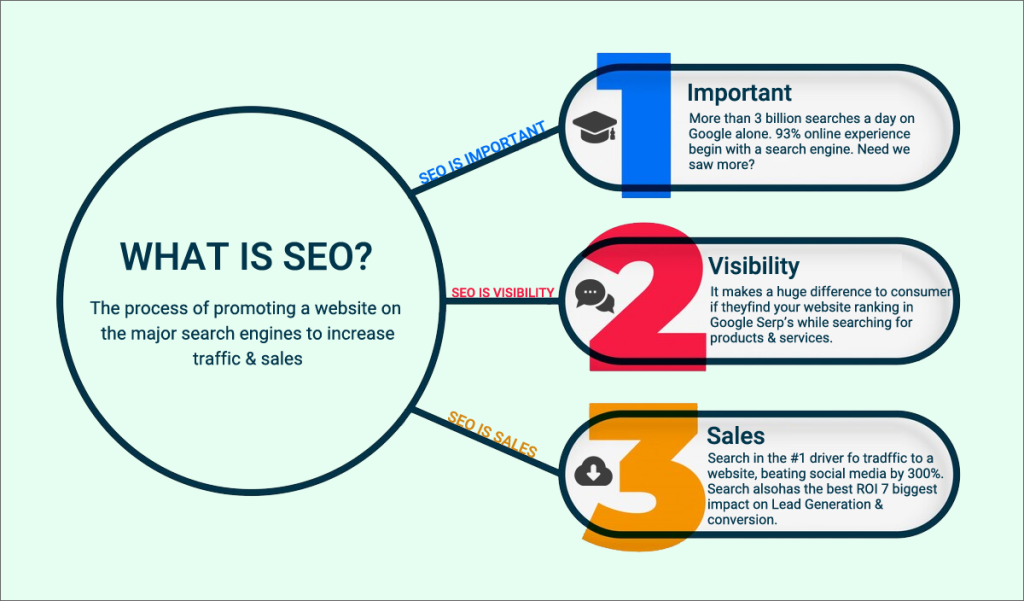
Search engines strive to provide the best service to users by delivering high-quality, highly relevant search results. To do this, they scan and analyze a wide array of web content to better understand various websites.
Through this scanning process, search engines can offer more accurate results to users searching for specific topics or keywords. They also assess a website’s readability and user-friendliness, rewarding those that offer a good user experience with higher rankings on the search engine results pages (SERPs).
SEO, or search engine optimization, is a strategy that businesses employ to ensure their websites rank highly in organic search results for relevant keywords and phrases. For example, you can optimize a blog post to target specific keywords so that the right audience finds your content. This way, your post is more likely to rank well when people search for terms like “unique garden planters.”
Understanding the myriad benefits of SEO is essential for business owners like you. By improving your website’s SEO, you can enhance its visibility on search engines, allowing you to reach your target audience and attract more potential customers. Well-crafted, SEO-focused content increases the likelihood of driving targeted organic traffic to your website.
By optimizing your website and content for better visibility and readability, you amplify the effectiveness of your SEO efforts. Instead of settling for low rankings on SERPs, you have the opportunity to rise to the top and expand your online visibility.
Different Factors Affect SEO and SEO Marketing
After understanding what SEO is and how it works, you might ask, “How exactly does one engage in SEO marketing?” or “Does SEO optimization really yield results?” The answer is that SEO marketing is effective and, when executed correctly, can yield remarkable results.
Let’s delve deeper into some of the factors that can influence your website’s performance in SEO.
It’s worth noting that Google, the dominant search engine, never publicly discloses the specific algorithm it uses to rank websites. However, through extensive observation and analysis, we have a solid understanding of some of the elements that influence rankings on SERPs.
These factors can be broadly categorized into on-page and off-page elements, both of which significantly impact a website’s visibility and ranking.
Content Marketing
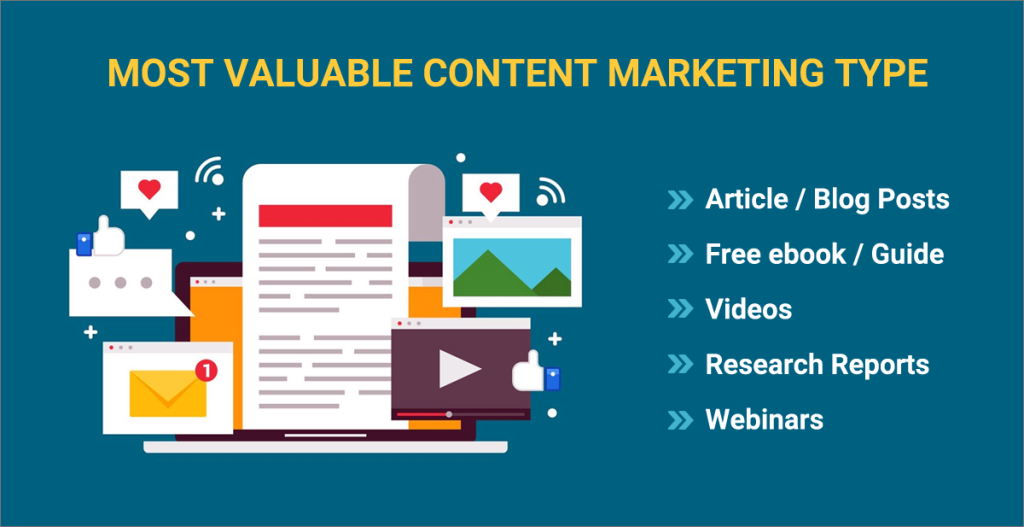
First, let’s understand the importance of content in the context of SEO. Content isn’t just crucial for attracting search engines; it’s also key for engaging your website visitors. The focus should be on creating content that resonates with your audience rather than just churning out material.
High-quality, relevant content can significantly boost your website’s chances of ranking higher in search results. Moreover, compelling content encourages users to spend more time on your website, potentially leading to conversions.
So, how do you create content that appeals to both search engines and human readers? The answer lies in diversifying the types of content you offer. By featuring a range of well-crafted articles that are relevant to your audience, you can optimize your website for both search engines and user experience. It’s also important to avoid duplicate content, as this can negatively impact your SEO efforts.
Here are some types of online content you can focus on to expand your content portfolio and, in turn, improve your search engine rankings:
- Blog Posts and Articles: Consistently publishing informative and engaging blog posts can establish your website as a valuable resource in your industry.
- Ebooks and Whitepapers: Offering in-depth resources like ebooks and whitepapers can demonstrate your expertise and provide valuable information to your target audience.
- How-to Manuals and Tutorials: Sharing step-by-step guides and tutorials can showcase your business’s expertise and help users solve specific problems.
- Social Media Content: Utilizing social media platforms allows you to share your content, engage with your audience, and drive more traffic to your website.
- Visual and Audio Material: Videos and podcasts can be highly engaging and offer an alternative way for users to consume your content.
- Infographics or Other Visual Content: Presenting information in visually appealing formats like infographics can simplify complex ideas, making them easier to understand and share.
Keyword research is another crucial element for making your content search-engine-friendly. Knowing the exact keywords relevant to your business allows you to better align your content with the search intentions of your target audience.
Freshness, or how often you publish new content, is another factor that can impact your search engine ranking. However, updating your content doesn’t always mean creating entirely new pieces. Existing articles can be edited, enhanced for greater impact, or refreshed with new data to keep them current.
While content creation may require an investment of time and resources, the returns are well worth it. High-quality content is prioritized by search engines and relied upon by consumers to understand the value your business provides. Start by publishing a few blog posts, and then work on building a social media following. Once you have a loyal audience, you can expand your content strategy to include diverse forms of media, thereby attracting and engaging new leads.
On-Page SEO Optimization
On-page SEO involves the elements directly located on a website, over which the site’s owner or administrator has full control. By implementing SEO best practices, a website owner can significantly influence and improve these on-page factors.
On-page SEO extends beyond just content marketing to encompass the technical aspects of a website’s HTML structure. By focusing on these elements, a website can elevate its position in Google’s search engine results.
Here are some key on-page SEO elements that can help boost your ranking in search engine results:
- Title Tag
Title tags play a pivotal role in search engine optimization, as they inform search engines about the purpose and content of each webpage. It’s advisable to keep title tags concise, ideally around 70 characters, incorporating both your company name and primary keyword.
Well-crafted title tags can substantially increase your website’s visibility in search engine results. When search engines crawl your site, they use the title tags to assess the relevance and context of your content. By formulating precise and informative title tags, you enhance your chances of attracting organic visitors and improving your search rankings.
For effective title tags, it’s essential to include relevant keywords that align with the subject matter of your content. Incorporating your company’s name alongside these keywords not only attracts the right audience but also instills trust with potential customers. Striking the right balance between conciseness and keyword relevancy encourages users to click on your link, thereby increasing the volume of potential consumers visiting your website.
- Meta Description
The meta description serves a dual purpose: it provides search engines with a brief summary of the content on each page and helps human users quickly understand the relevance of the page’s content to their search.
The meta description should contain key keywords while also offering enough detail to give users an accurate snapshot of the content. This allows both search engines and human users to quickly determine if the page aligns with their search intent.
- Sub Headings
Subheadings enhance the user experience by making content more digestible and easy to navigate. They offer logical breaks that facilitate skimming, helping readers find the information they seek more efficiently, which in turn increases engagement.
From an SEO perspective, subheadings are crucial. Search engines use header tags (H1, H2, H3, etc.) to understand the content’s hierarchy and relevance. Proper use of header tags establishes a structured hierarchy, aiding search engines in both indexing and ranking your content, thus improving its visibility in relevant search results. The end result is improved readability and user experience, which also positively impacts your site’s SEO.
- Internal Links
Internal links or hyperlinks that point to other pages on the same website improve both user experience and search engine optimization. These links make it easier for search engines to understand and navigate the site while also enabling users to find more in-depth information related to the topic they are reading about.
For example, if someone is writing a blog post extolling the virtues of a specific product or service, internal links can direct readers to the relevant product or service page on the website. This makes it easier for users to find additional details while helping search engines understand how various pages on the site relate to one another.
In summary, the effective use of internal links not only enriches the user experience by offering more contextual information but also enhances your website’s SEO by assisting search engines in understanding the structure and content of your site.
- Image Name and ALT Tags
When incorporating images into your website or blog posts, it’s crucial to use relevant keywords or phrases in both the image names and ALT text. Doing so helps search engines properly index these images, enhancing your SEO. However, be mindful to avoid over-optimization by cramming too many keywords, as this can result in penalties from search engines like Google.
Each piece of content should target one or two specific keywords to maintain focus and relevance. Attempting to optimize for too many keywords can lead to unfocused content and negatively impact your SEO efforts.
Site architecture is equally vital for SEO as content. To optimize your web pages effectively, implement a cohesive SEO strategy across the site. Employ a web design that enables search engines to easily scan and crawl your pages.
To improve your site’s crawlability, consider building internal links with relevant anchor text, creating a sitemap, and submitting it to search engines. These actions not only improve crawlability but also enhance search engines’ understanding of your content.
In today’s world, with a growing number of searches conducted on mobile devices, having a mobile-friendly website is essential. Ensure that your site is easily accessible and navigable on mobile platforms.
Improving page speed is another critical element. Slow-loading pages are likely to deter visitors, increasing your site’s bounce rate. Poor page performance can adversely affect both user experience and SEO optimization.
Also Read: Image SEO: How to Optimize Images for Google Image Search SEO?
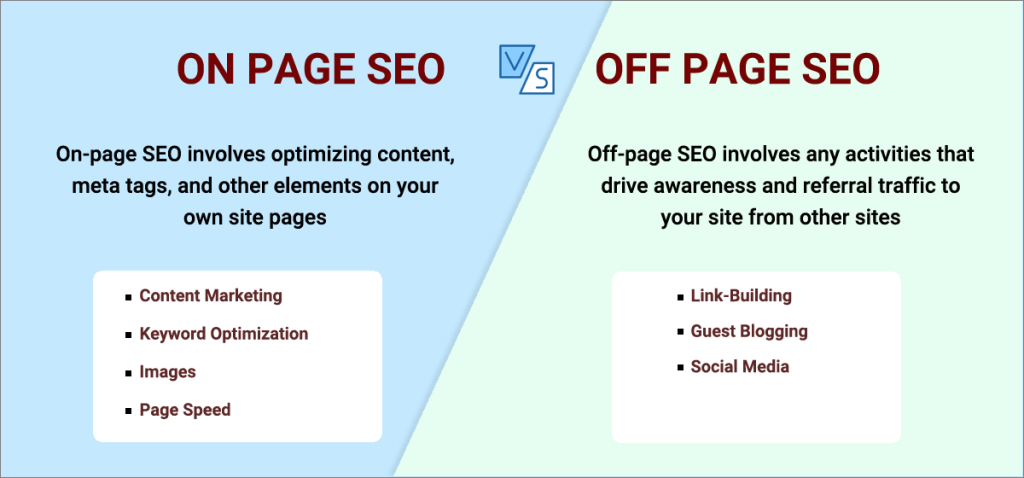
Off-Page SEO Optimization
Off-page SEO factors can influence your website’s ranking just as much as the on-page components you can control. Even though you may not have direct influence over these off-page elements, there are strategies to increase the likelihood that they will work in your favor.
Here are some key off-page SEO factors that can affect your search engine rankings:
- Trustworthiness
In the realm of website rankings, trust has become a pivotal factor. Google, as the leading search engine, puts significant emphasis on evaluating the legitimacy and trustworthiness of websites.
To bolster this trust factor, backlinks are essential. By acquiring high-quality backlinks from reputable websites, you can effectively enhance your site’s credibility and trustworthiness in the eyes of both consumers and search engines.
- Links
Backlinks are a crucial aspect of off-page SEO optimization. However, a cautionary note is warranted: careless link-building, such as spamming other websites, can lead to search engine penalties—something you undoubtedly want to avoid.
To sidestep such pitfalls, consider adopting a more strategic approach. Cultivate relationships with influential figures and quality content creators in your field. When these individuals recognize the value your site provides, they’re more likely to organically include backlinks to your content, boosting your site’s visibility and authority.
- Social
Social signals, including likes and shares on social media platforms, are another key element of off-page SEO. The focus should be on garnering quality shares from authoritative individuals to optimize your SEO performance.
Remember, you can’t directly control external factors that are outside the purview of your business. However, by consistently producing valuable and engaging content, you significantly enhance your chances of improving off-page SEO.
A well-thought-out SEO strategy imbued with meaningful content can attract a broader audience of search engine users. When your content is relevant and compelling, people are more likely to link to it and share it on social media. By establishing audience trust through credible content, you not only connect with your readers but also strengthen your standing with search engines, thereby boosting your overall SEO performance.
Understanding Black Hat and White Hat SEO

The terms “black hat” and “white hat” SEO are used to distinguish between two different approaches businesses take to optimize their websites for search engines.
Black hat SEO is often employed by those seeking immediate results and quick financial gains. These practitioners prioritize search engine optimization over user experience, often bending or breaking the rules to achieve rapid rankings and financial rewards. While such tactics may initially result in high rankings, they also risk penalties or outright bans from search engines. This short-term focus ultimately undermines the organization’s ability to build a sustainable website capable of generating consistent leads over time.
In contrast, white hat SEO is a long-term strategy aimed at optimizing websites for search engines while building a successful online business. It emphasizes creating a user-friendly digital experience and focuses on a human audience. By adhering to search engine guidelines, this approach aims to produce high-quality content that is easy to read and navigate.
It’s important to understand that although black hat SEO tactics may offer quick wins, search engines are likely to catch on to these unethical practices and penalize the website. In extreme cases, the penalties could be so severe that the site may never recover its previous standing.
For long-term success and steadily increasing organic traffic, the best approach is to follow ethical, white hat SEO best practices. By prioritizing the needs of human users and creating quality content, organizations can establish a lasting online presence and boost organic traffic to their websites.
Conclusion

Once you have a fundamental understanding of how SEO works, you can start making changes to your website to improve its SEO and climb the rankings on search engine results pages.
It’s essential to remember that many factors influence SEO, but the most crucial is whether your website’s content is valuable and relevant to your target audience. SEO is not an overnight process; results take time to materialize. It may take several months to see the fruits of your labor, so patience is key.
However, adhering to search engine best practices can significantly boost the effectiveness of your SEO initiatives. The secret to building a sustainable online business and attracting organic traffic is to offer high-quality content aimed at serving human readers.
FAQs
How effective is SEO for small businesses?
SEO’s effectiveness for small businesses hinges on several key elements. The initial step involves keyword research to identify relevant terms that potential customers might use while searching for products or services. Subsequently, the website’s structure, content, and metadata are optimized to align with these keywords.
Efforts are also made to improve user experience, increase website loading speed, and acquire high-quality backlinks. All these activities contribute to enhancing organic traffic and search engine rankings.
Can small businesses manage SEO on their own, or should they hire professionals?
While a plethora of online tools and resources make it possible for small businesses to handle SEO independently, the process can be complex and time-consuming. Given the expertise, experience, and resources that professionals bring to the table, hiring an SEO service or consultant can be advantageous. This allows small business owners to focus on their core operations while leaving SEO tasks to the experts.
How long does it take to see results from SEO efforts for small businesses?
The time required to see results from SEO can vary based on several factors, including industry competition, the current state of the website, and the effectiveness of the implemented SEO strategies. Typically, small businesses start noticing improvements in their organic rankings and traffic within a few months. However, for significant and enduring impact, ongoing optimization over an extended period is often required.
Are there any risks or pitfalls to be aware of when implementing SEO for small businesses?
While SEO offers numerous benefits, there are also risks and pitfalls to consider. One common mistake is resorting to unethical or “black hat” SEO tactics that violate search engine guidelines, which can negatively affect rankings and lead to penalties. It’s imperative to focus on ethical, sustainable SEO techniques.
Additionally, unrealistic expectations for high rankings or instant success can lead to disappointment. SEO is a long-term strategy requiring patience, consistent effort, and adaptability to the ever-changing search engine algorithms.
